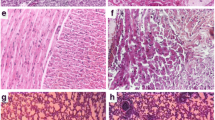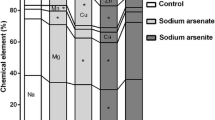Abstract
Chronic exposure to inorganic arsenic (iAs) is associated with neurotoxicity. Studies to date have disclosed that methylation of ingested iAs is the main metabolic pathway, and it is a process relying on reduced glutathione (GSH). The aim of this study was to explore the effects of exogenous GSH on arsenic burden and metabolism of nitric oxide (NO) in the brain of mice exposed to arsenite via drinking water. Mice were exposed to sodium arsenite through drinking water contaminated with 50 mg/L arsenic for 4 weeks and treated intraperitoneally with saline solution, 200 mg/kg body weight (b.w), 400 mg/kg b.w, or 800 mg/kg b.w GSH, respectively, at the 4th week. Levels of iAs, monomethylarsenic acid, and dimethylarsenic acid (DMAs) in the liver, blood, and brain were determined by method of hydride generation coupled with atomic absorption spectrophotometry. Activities of nitric oxide synthase (NOS) and contents of NO in the brain were determined by colorimetric method. Compared with mice exposed to arsenite alone, administration of GSH increased dose-dependently the primary and secondary methylation ratio in the liver, which caused the decrease in percent iAs and increase in percent DMAs in the liver, as a consequence, resulted in significant decrease in iAs levels in the blood and total arsenic levels in both blood and brain. NOS activities and NO levels in the brain of mice in iAs group were significantly lower than those in control; however, administration of GSH could increase significantly activities of NOS and contents of NO. Findings from this study suggested that exogenous GSH could promote both primary and secondary arsenic methylation capacity in the liver, which might facilitate excretion of arsenicals, and consequently reduce arsenic burden in both blood and brain and furthermore ameliorate the effects of arsenicals on NO metabolism in the brain.
Similar content being viewed by others
References
Aposhian HV, Zakharyan RA, Avram MD, Sampayo-Reyes A, Wollenberg ML (2004) A review of the enzymology of arsenic metabolism and a new potential role of hydrogen peroxide in the detoxication of the trivalent arsenic species. Toxicol Appl Pharmacol 198:327–335
Bolt HM, Stewart JD (2010) Arsenic: metabolism and transport mechanisms in human hepatocytes. Arch Toxicol 84:1–2
Bon CL, Garthwaite J (2001) Exogenous nitric oxide causes potentiation of hippocampal synaptic transmission during low-frequency stimulation via the endogenous nitric oxide-cGMP pathway. Eur J Neurosci 14:585–594
Calderón J, Navarro ME, Jimenez-Capdeville ME, Santos-Diaz MA, Golden A, Rodriguez-Leyva I, Borja-Aburto V, Díaz-Barriga F (2001) Exposure to arsenic and lead and neuropsychological development in Mexican children. Environ Res 85:69–76
Chen YC, Su HJ, Guo YL, Hsueh YM, Smith TJ, Ryan LM, Lee MS, Christiani DC (2003) Arsenic methylation and bladder cancer risk in Taiwan. Cancer Causes Control 14:303–310
Drobná Z, Walton FS, Paul DS, Xing W, Thomas DJ, Stýblo M (2010) Metabolism of arsenic in human liver: the role of membrane transporters. Arch Toxicol 84:3–16
Gamble MV, Liu X, Ahsan H, Pilsner R, Ilievski V, Slavkovich V (2005) Folate, homocysteine, and arsenic metabolism in arsenic-exposed individuals in Bangladesh. Environ Health Perspect 113:1683–1688
Gamble MV, Liu X, Ahsan H, Pilsner JR, Ilievski V, Slavkovich V, Parvez F, Chen Y, Levy D, Factor-Litvak P, Graziano JH (2006) Folate and arsenic metabolism: a double-blind placebo controlled folic acid supplementation trial in Bangladesh. Am J Clin Nutr 84:1093–1101
Gamble MV, Liu X, Slavkovich V, Pilsner JR, Ilievski V, Factor-Litvak P, Levy D, Alam S, Islam M, Parvez F, Ahsan H, Graziano JH (2007) Folic acid supplementation lowers blood arsenic. Am J Clin Nutr 86:1202–1209
Georis B, Cardenas A, Buchet JP, Lauwerys R (1990) Inorganic arsenic methylation by rat tissue slices. Toxicology 63:73–84
Guo JX, Hu L, Yand PZ, Tanabe K, Miyatalre M, Chen Y (2007) Chronic arsenic poisoning in drinking water in Inner Mongolia and its associated health effects. J Environ Sci Health A Tox Hazard Subst Environ Eng 42:1853–1858
Hayakawa T, Kobayashi Y, Cui X, Hirano S (2005) A new metabolic pathway of arsenite: arsenic-glutathione complexes are substrates for human arsenic methyltransferase Cyt19. Arch Toxicol 79:183–191
Heales SJ, Bolanos JP, Stewart VC, Brookes PS, Land JM, Clark JB (1999) Nitric oxide, mitochondria and neurological disease. Biochem Biophy Acta 1410:215–228
Heck JE, Gamble MV, Chen Y, Graziano JH, Slavkovich V, Parvez F, Baron JA, Howe GR, Ahsan H (2007) Consumption of folate-related nutrients and metabolism of arsenic in Bangladesh. Am J Clin Nutr 85:1367–1374
Hirano S, Kobayashi Y, Cui X, Kanno S, Hayakawa T, Shraim A (2004) The accumulation and toxicity of methylated arsenicals in endothelial cells: important roles of thiol compounds. Toxicol Appl Pharmacol 198:458–467
Hopper RA, Garthwaite J (2006) Tonic and phasic nitric oxide signals in hippocampal long-term potentiation. J Neurosci 26:11513–11521
Jin Y, Sun G, Li X, Li G, Lu C, Qu L (2004) Study on the toxic effects induced by different arsenicals in primary cultured rat astroglia. Toxicol Appl Pharmacol 196:396–403
Juárez-Reyes A, Jiménez-Capdeville ME, Delgado JM, Ortiz-Pérez D (2009) Time course of arsenic species in the brain and liver of mice after oral administration of arsenate. Arch Toxicol 83:557–563
Kile ML, Ronnenberg AG (2008) Can folate intake reduce arsenic toxicity? Nutr Rev 66:349–353
Lee MY, Jung BI, Chung SM, Bae ON, Lee JY, Park JD, Yang JS, Lee H, Chung JH (2003) Arsenic-induced dysfunction in relaxation of blood vessels. Environ Health Perspect 111:513–517
Lin GF, Du H, Chen JG, Lu HC, Guo WC, Golka K, Shen JH (2010) Association of XPD/ERCC2 G23591A and A35931C polymorphisms with skin lesion prevalence in a multiethnic, arseniasis-hyperendemic village exposed to indoor combustion of high arsenic coal. Arch Toxicol 84:17–24
Petrick JS, Ayala-Fierro F, Cullen WR, Carter DE, Aposhian HV (2000) Monomethylarsonous acid (MMA(III)) is more toxic than arsenite in Chang human hepatocytes. Toxicol Appl Pharmacol 163:203–207
Pi J, Kumagai Y, Sun G, Yamauchi H, Yoshida T, Iso H, Endo A, Yu L, Yuki K, Miyauchi T, Shimojo N (2000) Decreased serum concentrations of nitric oxide metabolites among Chinese in an endemic area of chronic arsenic poisoning in Inner Mongolia. Free Radic Biol Med 28:1137–1142
Pi J, Horiguchi S, Sun Y, Nikaido M, Shimojo N, Hayashi T, Yamauchi H, Itoh K, Yamamoto M, Sun G, Waalkes MP, Kumagai Y (2003) A potential mechanism for the impairment of nitric oxide formation caused by prolonged oral exposure to arsenate in rabbits. Free Radic Biol Med 35:102–113
Pi J, Yamauchi H, Sun G, Yoshida T, Aikawa H, Fujimoto W, Iso H, Cui R, Waalkes MP, Kumagai Y (2005) Vascular dysfunction in patients with chronic arsenosis can be reversed by reduction of arsenic exposure. Environ Health Perspect 113:339–341
Ríos R, Zarazúa S, Santoyo ME, Sepúlveda-Saavedra J, Romero-Díaz V, Jiménez V, Pérez-Severiano F, Vidal-Cantú G, Delgado JM, Jiménez-Capdeville ME (2009) Decreased nitric oxide markers and morphological changes in the brain of arsenic-exposed rats. Toxicology 261:68–75
Rodríguez VM, Del Razo LM, Limón-Pacheco JH, Giordano M, Sánchez-Peña LC, Uribe-Querol E, Gutiérrez-Ospina G, Gonsebatt ME (2005) Glutathione reductase inhibition and methylated arsenic distribution in Cd1 mice brain and liver. Toxicol Sci 84:157–166
Styblo M, Del-Razo LM, Vega L, Germolec DR, LeCluyse EL, Hamilton GA, Reed W, Wang C, Cullen WR, Thomas DJ (2000) Comparative toxicity of trivalent and pentavalent inorganic and methylated arsenicals in rat and human cells. Arch Toxicol 74:289–299
Sun G, Xu Y, Li X, Jin Y, Li B, Sun X (2007) Urinary arsenic metabolites in children and adults exposed to arsenic in drinking water in inner Mongolia, China. Environ Health Perspect 115:648–652
Thomas DJ, Styblo M, Lin S (2001) The cellular metabolism and systemic toxicity of arsenic. Toxicol Appl Pharmacol 176:127–144
Thomas DJ, Li J, Waters SB, Xing W, Adair BM, Drobna Z, Devesa V, Styblo M (2007) Arsenic (+3 oxidation state) methyltransferase and the methylation of arsenicals. Exp Biol Med (Maywood) 232:3–13
Tsai SY, Chou HY, The HW, Chen CM, Chen CJ (2003) The effects of chronic arsenic exposure from drinking water on the neurobehavioral development in adolescence. Neurotoxicology 24:749–753
Tseng CH, Huang YK, Huang YL, Chung CJ, Yang MH, Chen CJ (2005) As exposure, urinary As speciation, and peripheral vascular disease in blackfoot disease- hyperendemic villages in Taiwan. Toxicol Appl Pharmacol 206:299–308
Tsou TC, Tsai FY, Hsieh YW, Li LA, Yeh SC, Chang LW (2005) Arsenite induces endotelial cytotoxicity by down-regulation of vascular endothelial nitric oxide synthase. Toxicol Appl Pharmacol 208:277–284
Vahter ME (2007) Interactions between arsenic-induced toxicity and nutrition in early life. J Nutr 137:2798–2804
Wasserman GA, Liu X, Parvez F, Ahsan H, Factor-Litvak P, van Geen A, Slavkovich V, LoIacono NJ, Cheng Z, Hussain I, Momotaj H, Graziano JH (2004) Water arsenic exposure and children’s intellectual function in Araihazar, Bangladesh. Environ Health Perspect 112:1329–1333
Wasserman GA, Liu X, Parvez F, Ahsan H, Factor-Litvak P, Kline J, Geen A, Slavkovich V, Loiacono NJ, Levy D, Cheng Z, Graziano JH (2007) Water arsenic exposure and intellectual function in 6-year-old children in Araihazar, Bangladesh. Environ Health Perspect 115:285–289
Xi S, Sun W, Wang F, Jin Y, Sun G (2009) Transplacental and early life exposure to inorganic arsenic affected development and behavior in offspring rats. Arch Toxicol 83:549–556
Zarazúa S, Pérez-Severiano F, Delgado JM, Martínez LM, Ortiz-Pérez D, Jiménez-Capdeville ME (2006) Decreased nitric oxide production in the rat brain after chronic arsenic exposure. Neurochem Res 31:1069–1107
Acknowledgments
This study was financially supported by National Natural Scientific foundation of china (contract grant numbers: 30972441 and 30530640).
Author information
Authors and Affiliations
Corresponding author
Rights and permissions
About this article
Cite this article
Wang, Y., Zhao, F., Jin, Y. et al. Effects of exogenous glutathione on arsenic burden and NO metabolism in brain of mice exposed to arsenite through drinking water. Arch Toxicol 85, 177–184 (2011). https://doi.org/10.1007/s00204-010-0573-1
Received:
Accepted:
Published:
Issue Date:
DOI: https://doi.org/10.1007/s00204-010-0573-1




